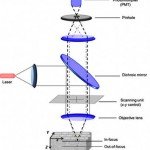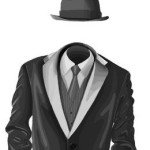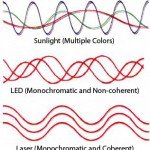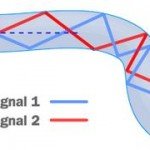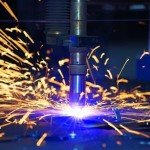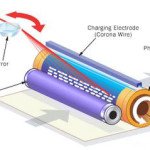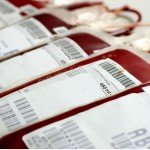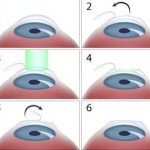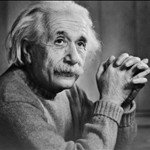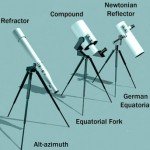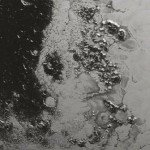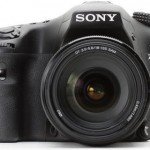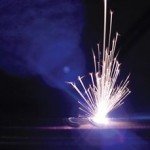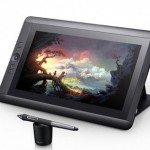The early history of lasers
The early history of lasers begins with the German-American physicist Albert Einstein (1879–1955). In 1917 Einstein published a paper entitled “On the Quantum Theory of Radiation” describing the process of stimulated emission for the first time. Neither in this paper nor afterward did he suggest any applications that might evolve out of his efforts to understand light.
He does not seem to have even considered the possibility that his work might have practical applications. A novel theoretical insight was enough for him, and there the matter rested for the next several decades. During this time, there were few experiments and no inventions employing the phenomenon of stimulated emission.
 To be sure, physicists accepted the existence of stimulated emission as a phenomenon. In order for stimulated emission to be useful, however, one would have to achieve a population inversion, and many thought that the laws of thermodynamics made the creation of such a state impossible. Consequently, no one bothered investigating it further. Stimulated emission seemed an interesting but not especially useful aspect of nature. It was, they supposed, one of nature’s little oddities.
To be sure, physicists accepted the existence of stimulated emission as a phenomenon. In order for stimulated emission to be useful, however, one would have to achieve a population inversion, and many thought that the laws of thermodynamics made the creation of such a state impossible. Consequently, no one bothered investigating it further. Stimulated emission seemed an interesting but not especially useful aspect of nature. It was, they supposed, one of nature’s little oddities.
Virtually all of the light that had shown on Earth since the beginning of time was incoherent light. They concluded, therefore, that the coherent laser light with which we are now so familiar, was impossible to create. After World War II, three physicists began working on the theoretical and practical problems of creating a device that would amplify electromagnetic radiation via the process of stimulated emission. Two of those physicists were from the Soviet Union, Aleksandr M. Prokharov (1916–2002) and Nikolay G. Basov (1922–2001). The third scientist was an American, Charles H. Townes (1915– ). They received little encouragement.
In fact, many of their colleagues actively discouraged them from continuing this line of research. In 2001, the year before his death, Prokharov told Russian state television that many of his fellow scientists thought that he and Basov were “crazy” to try to achieve something that was so obviously impossible. In the United States, Townes’s colleagues asked that his funding be cut because he was simply wasting money. By the time of their request, Townes had already spent $30,000, a substantial amount of money at the time. Fortunately, neither Townes nor Prokharov and Basov were not easily discouraged, and in 1964 all three received the Nobel Prize for their work in this field. The three physicists’ work resulted in the creation of a device called a maser, an acronym for “microwave amplification by stimulated emission of radiation,” a device that is similar in concept (as well as in name) to the laser.
 Townes was the first to create a maser. Recall that light consists of those wavelengths of electromagnetic radiation that are visible. When light waves impinge on the human retina, specialized structures on the retina, called rods and cones, emit nerve impulses that travel to the brain along the optic nerve, with the result that the observer sees those objects that reflected the light. By contrast, while microwaves may enter the eye, they do not have the same effect on the rods and cones. They are, as a consequence, invisible. Microwaves, which have wavelengths between 1 millimeter and 1 meter, are another small segment of the invisible part of the electromagnetic spectrum. Townes, Prokharov, and Basov discovered how to create a device based on the same general principles as a laser but that “shone” in the microwave part of the spectrum. To create this device, these scientists had to overcome the same basic problems that Maiman later overcame. Townes was the first to construct a working maser. The first choice he had to make was to find a material that would emit microwaves via the process of stimulated emission. He chose ammonia gas—ammonia because it exhibited the phenomenon of stimulated emission in the microwave region of the spectrum and a gas because it enabled him to physically separate individual molecules in a way that was both efficient and relatively fast. (An ammonia molecule consists of one nitrogen and three hydrogen atoms.) Not surprisingly, Townes’s maser was technically quite different from Maiman’s laser.
Townes was the first to create a maser. Recall that light consists of those wavelengths of electromagnetic radiation that are visible. When light waves impinge on the human retina, specialized structures on the retina, called rods and cones, emit nerve impulses that travel to the brain along the optic nerve, with the result that the observer sees those objects that reflected the light. By contrast, while microwaves may enter the eye, they do not have the same effect on the rods and cones. They are, as a consequence, invisible. Microwaves, which have wavelengths between 1 millimeter and 1 meter, are another small segment of the invisible part of the electromagnetic spectrum. Townes, Prokharov, and Basov discovered how to create a device based on the same general principles as a laser but that “shone” in the microwave part of the spectrum. To create this device, these scientists had to overcome the same basic problems that Maiman later overcame. Townes was the first to construct a working maser. The first choice he had to make was to find a material that would emit microwaves via the process of stimulated emission. He chose ammonia gas—ammonia because it exhibited the phenomenon of stimulated emission in the microwave region of the spectrum and a gas because it enabled him to physically separate individual molecules in a way that was both efficient and relatively fast. (An ammonia molecule consists of one nitrogen and three hydrogen atoms.) Not surprisingly, Townes’s maser was technically quite different from Maiman’s laser.
By contrast with chromium atoms, which make the transition to a metastable state via a three-step process—ground state to higher state to metastable state—ammonia molecules experience only two states, a higher and lower one. Stimulated emission can be elicited from the higher energy state of the ammonia molecule provided one can create a population inversion. Townes’s approach to the creation of a population inversion was entirely different from that of Maiman. Whereas Maiman excited chromium atoms into a higher energy state by adding energy to the laser crystal via his xenon lamp, Townes made use of the fact that in any population of ammonia molecules at least a few of the molecules are already in the higher energy state. Under normal conditions, however, the higher energy molecules simply are not dense enough in the gas to enable the phenomenon of stimulated emission to occur. In order to facilitate the phenomenon of stimulated emission, Townes had to increase the percentage of molecules in the higher energy state. In other words, he had to create a population inversion. Townes achieved this by removing the molecules in the lower state and thereby creating a new population consisting largely of molecules in the higher energy state. Notice that he did not raise the energy level of any molecule but, instead, created a new population by separating out the higher energy molecules from the lower energy ones. The key to this approach is that the electrical properties of the ammonia molecules in the ground state are different from those of ammonia molecules in the higher energy level.
Townes made use of this fact by injecting ammonia gas into a chamber, called a focuser, in which he had created an electrical field. The way that the ammonia molecules interacted with the electrical field depended on their energy level. As the gas passed through this chamber, the molecules in the lower energy state were directed out of the stream. The remaining molecules, consisting of those in the higher energy state, were funneled by the electrical field into a chamber. In other words, he obtained a population inversion by retaining only those molecules already in the higher energy state. The chamber in which the higher energy molecules were directed was designed so that the microwaves could reflect back and forth inside the chamber, creating a highly coherent, more powerful wave via the phenomenon of stimulated emission.
In Townes’s device, the emitted frequency of the resulting electromagnetic wave was approximately 24 gigahertz, which corresponds to a wavelength of approximately 1.25 centimeters. Like Maiman, Townes needed to find a way to get some of the resulting electromagnetic energy out of the resonator, but at the wavelengths at which Townes was working there was no need for the clever solution of a partially reflective surface. Townes simply made a small hole in the resonator through which some of the coherent microwave energy could escape.
Who Invented the Laser?
In one of the longest, most contentious legal battles in the history of the U.S. Patent Office, the American Gordon Gould (1920– ) proved that he invented the laser, and he has the patents to prove it. A patent is a form of property, the ownership of which is granted by a government. Patents are granted to inventors for the machines, manufacturing processes, chemicals, genetically engineered plants or animals, or other new and useful inventions that they have created.
Significant improvements to existing machines, manufacturing processes, and so on, may also be patentable. The patent is a statement by the government that the inventor owns the invention in question. Because the owner of the patent is the owner of the invention, he or she is entitled to either prevent others from using or manufacturing the invention in question or to grant others the privilege of using or manufacturing the invention, usually for a fee. The patent is granted for a limited time. Patents make it possible for inventors to profit from their inventions, and without patents there would be less incentive for inventors to invent.
Today, the news media contain many stories about “intellectual property,” of which the patent is but one type, but governments have long recognized the importance of patents in promoting inventions. Patents were issued in Italy during the Renaissance, and the concept of patents is part of the U.S. Constitution: Article I, Section 8 states, in part, that the Congress shall have power “To promote the progress of science and useful arts by securing for limited times to authors and inventors the exclusive rights to their respective writings and discoveries.” The laser is one of the most significant inventions of the 20th century.
The creation of the laser was an important scientific breakthrough. Nobel Prizes have been awarded for work on or with lasers, and lasers have been used in numerous scientific, medical, and consumer apparatus, where they play an indispensable role. With so much depending on the laser, it was important to determine its rightful inventor, and because the laser is so important, it is not surprising that more than one individual has claimed to have invented it. To understand the source of confusion, it helps to know about two important aspects of U.S. patent law. First, the patent for an invention is awarded to the first person to invent an object or process and not necessarily the first person to file a patent application. Second, to obtain a patent one need not build a working model for a device; one need only describe the device in sufficient detail so that a person “skilled in the art”—an old-fashioned way of describing someone expert in the relevant specialty—could construct the device from the description. This is why Theodore Maiman is credited with building the first working laser but not with inventing the laser. Gordon Gould fulfilled both requirements for the patent, but as a novice inventor he was a little unclear about the need to produce a working invention. Gordon Gould graduated from Union College in Schenectady, New York, in 1941. He received a master’s degree from Yale University and was working on his Ph.D., which involved using light to raise the energy levels of thallium atoms, a technique that is often referred to as “optical pumping,” at Columbia University in 1957, when the idea of the laser occurred to him. (During World War II, he had also worked on the Manhattan Project, the code name for the project that resulted in the creation of atomic weapons.) At the time Gould attended, Columbia University had one of the most successful physics programs in the world. There were many outstanding scientists on the faculty, and many of its graduates later made important discoveries. Among the faculty members was Charles Townes, the inventor of the maser.
Gould was lying in bed on a Saturday night when the idea of a laser occurred to him. Apparently, the idea occurred to him in a flash. But it was more than an idea. As none of his contemporaries did, Gould understood the value of the laser as a tool; he understood its applications. That night Gould got out of bed and began keeping a laboratory notebook in which he carefully described his ideas and sketched diagrams. The title he gave the notebook was “Some rough calculations on the feasibility of LASER: Light Amplification by Stimulated Emission of Radiation.” (Recall that the term laser was also invented by Gould.) Gould described a tube containing vapor. A light source would create a population inversion among the atoms contained within the tube. At each end of the tube, there would be mirrors, one of which would be partially transparent, that would cause the photons, produced by stimulated emission, to reflect back and forth, creating an intense and coherent wave. Because the beam could travel large distances while remaining focused, he recognized that it had applications to communications, and because it could be focused into a small volume (and because the energy is inversely proportional to the wavelength), laser light could be used to heat solids and liquids to extremely high temperatures almost instantly. This was the beginning of Gould’s great insights into lasers, and when he had completed nine pages of the notebook, he had each page notarized. When Gould eventually filed for a patent 18 months later, his application included the use of mirrors to create the oscillations, two methods of creating a population inversion—one used light and the second used “collisions of the second kind,” a now-common method that involves collisions between atoms or molecules of various types, a device called a Q-switch, and other ideas.
Further, he described how one might use lasers to initiate chemical reactions, measure distances, heat materials, communicate, and improve radar. There would be many arguments about who invented the laser, but no one could argue that Gould did not more clearly envision its uses than his contemporaries. The Q-switch, a device described by Gould in his original application, is an innovation that controls the resonance properties of the laser cavity. Initially, it makes the laser cavity less resonant. This prevents a coherent beam of light from forming because the photons are not reflected between the two ends of the cavity. Meanwhile, energy continues to flow into the medium with the result that a very strong population inversion is created. When a very high proportion of the atoms or molecules are in the higher, metastable state, the switch is reversed so that suddenly the laser cavity becomes highly resonant, at which time a coherent wave sweeps through the highly charged laser medium. This results in the emission of a very brief and powerful laser pulse.
The cycle is then repeated. Today, the Q-switch is often utilized in laser designs. Gordon Gould saw deeply into the technology of lasers, as well as how they might be utilized. Unfortunately for Gould, the team of Townes and Arthur Schawlow (1921–1999), a prominent scientist at Bell Labs, also claimed to have invented the laser. Their patent was filed first, and they were far more prominent among scientists than Gould. (Townes was especially prominent after receiving the Nobel Prize.) In the competition, therefore, between Townes and Schawlow on the one hand and Gould on the other, there were few in the scientific establishment willing to consider the possibility that the otherwise obscure Gordon Gould had, in fact, created the laser.
As his claim slowly made its way through the legal process, Townes and Schawlow continued to collect licensing fees. (It was later shown that the design that they described in their patent application would not have worked and that one important aspect of their design was identical with an idea that Gould communicated to Townes prior to either one filing a patent application.) Further, as lasers became more commonly used, Gould’s claim, were he successful, would have required large payments to him on the part of laser companies and other companies that used lasers. Many companies, including a consortium of laser companies, General Motors, which was already using laser technology, and Bell Laboratories, the most successful research and development laboratory of the 20th century, sought to quash his patent application. They spoke dismissively of him; they even insulted him. One patent attorney for Bell Labs even described Gordon Gould as “a kook.” Gould did not invent the laser, asserted the attorney, and “ . . . we [Bell Labs] have the patents to prove it.” (Bell Labs held some laser patents for inventions that Gould asserted were his own.) Gould persisted.
His claims were examined and reexamined by the Patent and Trademark Office and numerous courts of law. These patents are some of the most carefully scrutinized patents in U.S. history, and 30 years after he first sat upright in bed on a Saturday night and went into the kitchen to get a laboratory notebook, Gordon Gould won his case. He proved in court that he invented the laser, and today, he has the patents to prove it.


